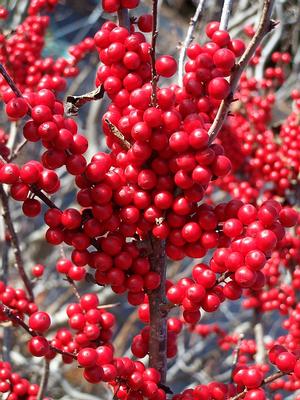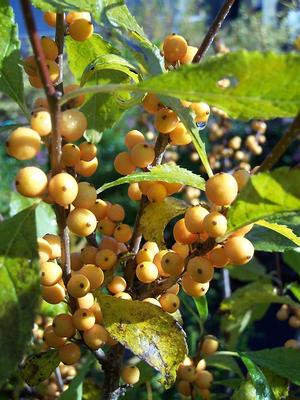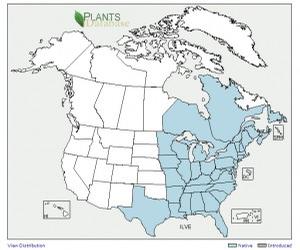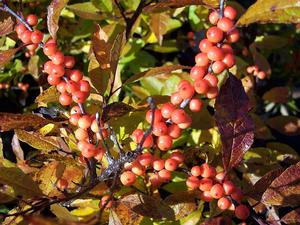
Ilex verticillata 'Winter Red'

Ilex verticillata 'Golden Verboom'

USDA map displaying nativity of Ilex verticillata

Ilex verticillata 'Winter Gold'
Ilex verticillata - The Winterberries
When one examines the Winterberries, Ilex verticillata, it can become a broad and complicated discussion. There are a number of species female selections. There are also hybrid selections. As these hollies are dioecious meaning shrubs are either male or female one of each sex must reportedly be present for pollination of female flowers or fruiting may not result. So, there are male species selections. Pairing an appropriate male to female can be daunting for the uninitiated but pollination is basic: if the timing of flowers overlap in male and female selections and if they are not miles away from each other, i.e. if near enough that pollinating insects visit both then pollination will almost likely occur. For purposes of simplicity we are going to hone on four female selections of Ilex verticillata and an appropriate male pollinator. But even that discussion is fraught. Apparently, Ilex pollination may not be as cut and dry as many purport.
The native range for Winterberry is broad. They are found in a speckling of counties in east Texas and dotted due north from Louisiana through Minnesota. From its western range it is found in all states east with occurrence increasing as one grows closer to the northeast. Ilex verticillata inhabits every county from the eastern seaboard states of New Jersey, Connecticut, Rhode Island, Massachusetts, New Hampshire and Maine. It can be found in any of the wild spaces remaining on Long Island. Extending its northern range excepting Newfoundland and Labrador in Canada Winterberry is broadly found in Ontario and all provinces east to the Atlantic Ocean.
For those of us who live in the northeast adjacent to woodlands and especially those of us living in states with Atlantic coastline (except some areas in inland New York State) male pollinators may be unnecessary as wild plants appear to be everywhere. Certainly, at Quackin' Grass all of our female selections fruit prolifically each and every year whether we have had no named male selections on site. And though we have had no verification nor do we know if studies have even been performed we also think it just may be possible that some cross-species male to female pollination is transpiring. Our circumstantial evidence is that with no males present for our female selections of Ilex glabra (Inkberry), Ilex cornuta 'Rotunda' (dwarf Chinese Holly) and Ilex crenata selections (Japanese Holly) these all produce copious berries annually. On the property the male hollies which are potential pollinators are Ilex x meserveae 'Blue Boy', 'Blue Prince' and 'Prince Charming', miniature Ilex x 'Jersey Male' (one of the Rutger's Hybrids complex), Ilex pedunculosa (an Asian Long-stalk Holly) and Ilex mucronata (our eastern Long-stalk Holly) plus the wild-occurring male Ilex verticillata populating our adjacent woodlands.
So, unless there are possibly some male sexual parts which occur on female clones of a given Ilex species then it appears that inter-species pollination is not only possible but likely. If so, then only controlled studies will tell us the facts as to which configurations of species are possible and most effecting at pollination and resultant berry production. In any event determination would make for an interesting PhD / university study and one that might be considered by an adventurous agricultural student and / or professor.
A male clone for shrubs planted in more southerly locales where wild populations trend spottier 'Southern Gentleman' may be an appropriate choice. It is fundamental that flowering times overlap so that male pollen may be transported to awaiting female pistils by foraging insects. In the north where needed or if one wishes to hedge ones bets 'Jim Dandy' is a fine male pollinator.
As implied, basic and fundamental to berry production is, of course, vibrant and busy pollinating insect populations plus male and female plants whose flowering times overlap and are not planted far away from each other. It's safe to say that the closer a male is planted to five or possibly six females the more likely pollination will be achieved. Generally it is thought that a ratio of one male to five females is adequate but there is undoubtedly some flexibility in that equation especially when a plethora of many busy vectors are accidentally performing pollination services while seeking nectar. In excellent cultural conditions a maximum number of flowers may draw more pollinators and set a high baseline for berry production. The insect species responsible for pollination and how far they range during their lifetimes may determine the outside perimeters of male to female distance.
Four female cultivars of note each have specific differences among them which make them worthy of consideration. There are a growing roster of species and hybrids worthy of consideration. The following four are varietal species selections that are favorites of ours, all of which we have grown and observed for years. Ilex verticillata ‘Golden Verboom’ is a Dutch Winterberry find with bright yellow fruit. Originally intended for the cut flower trade the fruit is, indeed, warm bright yellow. Berry production is prolific. This selection would be beautiful set before evergreens where the fruit would be a standout in autumn and into winter. There are a number of nurseries repeating the same mantra that 'Golden Verboom' requires a 'Golden Verboom' male for pollination. Curiously, we have never actually run across a 'Golden Verboom' male and we think it a fictitious creature as 'Golden Verboom' is female... Our plants form burgeoning fruit clusters annually with the mix of male Ilex of various parentage and species on Quackin' Grass Nursery's grounds as previously reported. 'Golden Verboom' is also a knockout when set with the following two selections when all are berried. The distinct berry colors contrast and glow when the light grows softer as the days shorten.
Ilex verticillata ‘Winter Gold’ is a selection of Winterberry with bright pale orange fruit in some autumns and yellow touched with pink in others. 'Southern Gentleman' which can grow to 8 feet tall would make for smart pairing down south. 'Winter Gold' was a branch sport found on the following entry, 'Winter Red'.
Two characteristics make Ilex verticillata ‘Winter Red’ a choice selection. First, the fat berries are an exceptionally glowing, rich, deep and saturated red. Second, 'Winter Red' has the most persistent fruit of any Winterberry cultivar I have yet run across. I remember being at Arnold Arboretum on March 10, 2008 with Russell Stafford of Odyssey Bulbs when we happened upon a planting. The opulent berries were as fresh, deep red and captivating as they had been no doubt on November 10. It was a surprise that the birds had not discovered them. Stems are dark purple-brown. 'Southern Gentleman' would also be an appropriate mate in the south.
Ilex verticillata 'Sunsplash' Discovered at Broken Arrow Nursery this female form of Winterberry has all foliage splashed, spotted and streaked in bright yellow. Fruits are small and scarlet... there are better berrying forms but none sport variegated leaves! This selection has not only been slower growing but has also remained shorter in the gardens at Quackin' Grass having achieved about 4 to 5 feet with a tendency towards slow colonization, this after about 10 years in the ground. 'Jim Dandy' would be an appropriate male pollinator. 'Jim Dandy' has been sold under two other names, "Dwarf Male" and "Early Male". It is a heavy producer of pollen, slow growing and may grow 5 feet tall, perhaps a bit taller over time but tends to remain shorter than other males.
Speaking of other males achieving between 6 and 9 feet tall with nice green foliage and a broad habit is 'Raritan Chief'. 'Apollo', on the other hand, is a giant hybrid growing to 12 feet whose parents are Ilex serrata x I. verticillata producing great quantities of pollen consistently.
One cultivar which we will no longer offer is 'Red Sprite'. This alleged shorter-growing selection, often sold as a plant that will grow only 4 to 6 feet or so tall in good conditions has in good conditions now risen to a staggering 8 feet tall. Unless we were originally sold a plant as 'Red Sprite' which was not then we cannot recommend it. A better selection for red berries hands down is 'Winter Red'; fruits are larger, deeper in color and more numerous. If a shorter plant is your goal and variegated leaves do not put you off then 'Sunsplash' would be a more appropriate option. 'Shortcake' and 'Shaver', which purportedly grow 5 and 6 feet respectively may be good choices. 'Oosterwijk' allegedly grows only 4 to 6 feet tall. We have not actually grown these three and cannot report from personal experience.
Growing typically from 6 to 8 feet tall, excepting 'Sunsplash', once a shrub settles in and makes good growth an Ilex verticillata can achieve equal breadth. In Connecticut they can often be seen roadside growing in drainage ditches also in open, sunny swampy areas. That's a clue to winterberry's cultural requirements. Site Ilex verticillata in full to nearly full sun exposure planted in fertile moisture-retentive soil. An average soil is adequate but they do relish a good, deep moist loam. Winterberry is hardy from USDA zone 3 through 9. All winterberries are good wildlife plants as many birds eat the fruit in winter when food becomes increasingly scarce. Unfortunately, deer also enjoy the fruit and will strip a shrub in a single night. But back to the birds: during Christmas week in 2009, after a blizzard that left a blanket of snow approximately 17” deep, a small flock of robins visited 'Winter Gold' daily until they eventually picked off every last fruit. They gobbled with gusto. The plethora of berries was reduced to zero very quickly!
penned by Wayne Paquette, 2015